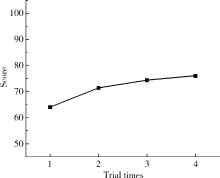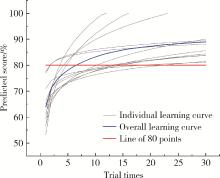北京大学学报(医学版) ›› 2023, Vol. 55 ›› Issue (1): 108-113. doi: 10.19723/j.issn.1671-167X.2023.01.016
上颌中切牙全瓷冠牙体预备学习曲线的预测、分析与应用
吴思妤,李娅宁,张晓,吕珑薇,刘云松,叶红强*( ),周永胜*(
),周永胜*( )
)
- 北京大学口腔医学院·口腔医院修复科, 国家口腔医学中心, 国家口腔疾病临床医学研究中心, 口腔生物材料和数字诊疗装备国家工程研究中心, 口腔数字医学北京市重点实验室, 北京 100081
Prediction, analysis and application of learning curve of tooth preparation for all ceramic crowns of maxillary central incisors
Si-yu WU,Ya-ning LI,Xiao ZHANG,Long-wei LV,Yun-song LIU,Hong-qiang YE*( ),Yong-sheng ZHOU*(
),Yong-sheng ZHOU*( )
)
- Department of Prosthodontics, Peking University School and Hospital of Stomatology & National Center of Stomatology & National Clinical Research Center for Oral Diseases & National Engineering Research Center of Oral Biomaterials and Digital Medical Devices & Beijing Key Laboratory of Digital Stomatology, Beijing 100081, China
摘要:
目的: 运用改良Wright学习曲线模型预测参加口腔住院医师规范化培训的研究生在仿真头颅模型上进行上颌中切牙全瓷冠牙体预备的学习曲线, 分析其特点, 并用于评价牙体预备的效果。方法: 选取12名参加口腔住院医师规范化培训的研究生在仿真头颅模型上进行4次右上中切牙树脂牙的全瓷冠牙体预备, 预备体由3名具有10年以上口腔修复经验的专家按照预备量、外形轮廓、聚合度、肩台、边缘线角及位置、邻牙损伤和预备时长等方面进行评价。根据4次牙体预备分数计算牙体预备的学习率, 用改良Wright学习曲线函数预测牙体预备的学习曲线。参考北京市住院医师规范化培训技能考核要求, 以80分作为合格的考核标准, 推算牙体预备技能达到考核标准(80分)所需的最少训练次数, 分析学习曲线的特点, 评价牙体预备的效果。结果: 4次牙体预备的分数分别为(64.03±7.80)分、(71.40±6.13)分、(74.33±5.96)分、(75.98±4.52)分, 学习率为(106±4)%, 学习曲线呈上升趋势。第5~13次牙体预备预测分数与考核标准的差异无统计学意义(P > 0.05), 第14次的牙体预备预测分数高于考核标准(P < 0.05)。结论: 参加口腔住院医师规范化培训的研究生在仿真头颅模型上进行上颌中切牙全瓷冠牙体预备的学习曲线呈上升趋势, 学习曲线预测14次是牙体预备分数高于考核标准所需的最少训练次数。
中图分类号:
- R783.2
| 1 |
周永胜, 江泳, 徐军, 等. 仿真头颅模型在口腔修复学临床前期教学中的应用[J]. 中华医学教育杂志, 2006, 26 (3): 74- 76.
doi: 10.3760/cma.j.issn.1673-677X.2006.03.031 |
| 2 | 刘星纲, 刘利霞, 魏永杰. 浅析研究生修复实习中牙体预备的学习曲线[J]. 北京口腔医学, 2018, 26 (4): 236- 237. |
| 3 | Wright TP . Factors affecting the cost of airplanes[J]. J Astronaut Sci, 1936, 3 (4): 122- 128. |
| 4 |
Sun TM , Lan TH , Pan CY , et al. Dental implant navigation system guide the surgery future[J]. Kaohsiung J Med Sci, 2018, 34 (1): 56- 64.
doi: 10.1016/j.kjms.2017.08.011 |
| 5 |
Lim JH , Park JM , Kim M , et al. Comparison of digital intraoral scanner reproducibility and image trueness considering repetitive experience[J]. J Prosthet Dent, 2018, 119 (2): 225- 232.
doi: 10.1016/j.prosdent.2017.05.002 |
| 6 |
Ben-Gal G , Katorza L , Weiss EI , et al. Testing motor learning curves among dental students[J]. J Dent Educ, 2017, 81 (10): 1171- 1178.
doi: 10.21815/JDE.017.076 |
| 7 |
Son K , Lee WS , Lee KB . Prediction of the learning curves of 2 dental CAD software programs[J]. J Prosthet Dent, 2019, 121 (1): 95- 100.
doi: 10.1016/j.prosdent.2018.01.004 |
| 8 |
Son K , Lee KB . Prediction of learning curves of 2 dental CAD software programs, part 2: Differences in learning effects by type of dental personnel[J]. J Prosthet Dent, 2020, 123 (5): 747- 752.
doi: 10.1016/j.prosdent.2019.05.026 |
| 9 |
Goodacre CJ , Campagni WV , Aquilino SA . Tooth preparations for complete crowns: An art form based on scientific principles[J]. J Prosthet Dent, 2001, 85 (4): 363- 376.
doi: 10.1067/mpr.2001.114685 |
| 10 | 赵铱民. 口腔修复学[M]. 7版 北京: 人民卫生出版社, 2012: 96- 97. |
| 11 | 周永胜. 口腔修复学[M]. 3版 北京: 北京大学医学出版社, 2020: 87- 89. |
| 12 |
Al Amri MD , Sherfudhin HR , Habib SR . Effects of evaluator's fatigue and level of expertise on the global and analytical evaluation of preclinical tooth preparation[J]. J Prosthodont, 2018, 27 (7): 636- 643.
doi: 10.1111/jopr.12558 |
| 13 | 李坚, 李泽. 学习曲线与进步函数: 考虑技术进步因素的优化方法[J]. 水利电力机械, 1997, (1): 3- 9.3-9, 11 |
| [1] | 赵然,刘延青,田华. 应用累积和控制图分析全膝关节置换术中电子压力垫片指导软组织平衡的学习曲线[J]. 北京大学学报(医学版), 2023, 55(4): 658-664. |
| [2] | 孙玉春,郭雨晴,陈虎,邓珂慧,李伟伟. 口腔精准仿生修复技术的自主创新研发与转化[J]. 北京大学学报(医学版), 2022, 54(1): 7-12. |
| [3] | 马珂楠,陈虎,沈妍汝,周永胜,王勇,孙玉春. 选择性激光熔化打印可摘局部义齿圆环形卡环固位力的有限元分析[J]. 北京大学学报(医学版), 2022, 54(1): 105-112. |
| [4] | 乔迪, 董艳梅, 高学军. 体外评价新型根尖倒充填材料iRoot的生物学性能[J]. 北京大学学报(医学版), 2016, 48(2): 324-329. |
| [5] | 刘宁, 黄广林, 满立波, 何峰, 王海东, 王海, 李贵忠, 王建伟. 缩短钬激光前列腺剜除术学习曲线的方法[J]. 北京大学学报(医学版), 2015, 47(4): 720-723. |
| [6] | 白伟, 林红, 郑刚. 一步法粘接剂对金属、陶瓷材料粘接性能的研究[J]. 北京大学学报(医学版), 2014, 46(2): 336-338. |
| [7] | 张树栋,马潞林,黄毅,庄申榕,邱敏,毕海,廖文峰. 经脐单孔腹腔镜肾切除术的技术改进[J]. 北京大学学报(医学版), 2013, 45(4): 579-. |
| [8] | 郑卫, 吴鑫, 张雷, 宋刚, 张争, 龚侃, 宋毅, 李学松, 何志嵩, 周利群. 腹腔镜膀胱全切手术:单中心60例学习曲线结果分析[J]. 北京大学学报(医学版), 2012, 44(4): 558-562. |
| [9] | 董颖韬, 王晓燕, 高学军. 树脂粘固剂厚度对CAD/CAM长石质陶瓷断裂性能的影响[J]. 北京大学学报(医学版), 2012, 44(2): 299-302. |
| [10] | 刘亦洪, 朱彦红, 邓启煌 . MSP试验法评价牙科叠层陶瓷材料的强度性能[J]. 北京大学学报(医学版), 2011, 43(6): 891-894. |
| [11] | 周团锋, 王新知, 张桂荣. 前牙IPS热压铸造全瓷粘接桥修复的3年临床应用研究[J]. 北京大学学报(医学版), 2011, 43(1): 77-80. |
| [12] | 李凌, 吕培军, 王勇. 氧化锆牙科陶瓷低温老化性能的研究[J]. 北京大学学报(医学版), 2011, 43(1): 93-97. |
| [13] | 刘亦洪, 冯海兰, 刘光华, 沈志坚. 全瓷修复体饰瓷疲劳损伤的初步分析[J]. 北京大学学报(医学版), 2010, 42(1): 46-49. |
| [14] | 李健慧*, 邸萍*, 胡秀莲, 邱立新, 崔宏燕, 林野. 应用无创瓷贴面技术改善种植区域美学效果的临床研究乳头[J]. 北京大学学报(医学版), 2010, 42(1): 103-107. |
| [15] | 刘亦洪, 冯海兰, 包亦望, 邱岩. 基底瓷与饰瓷的厚度比对IPS Empress Ⅱ热压铸陶瓷抗弯强度的影响[J]. 北京大学学报(医学版), 2007, 39(1): 64-66. |
|
||




